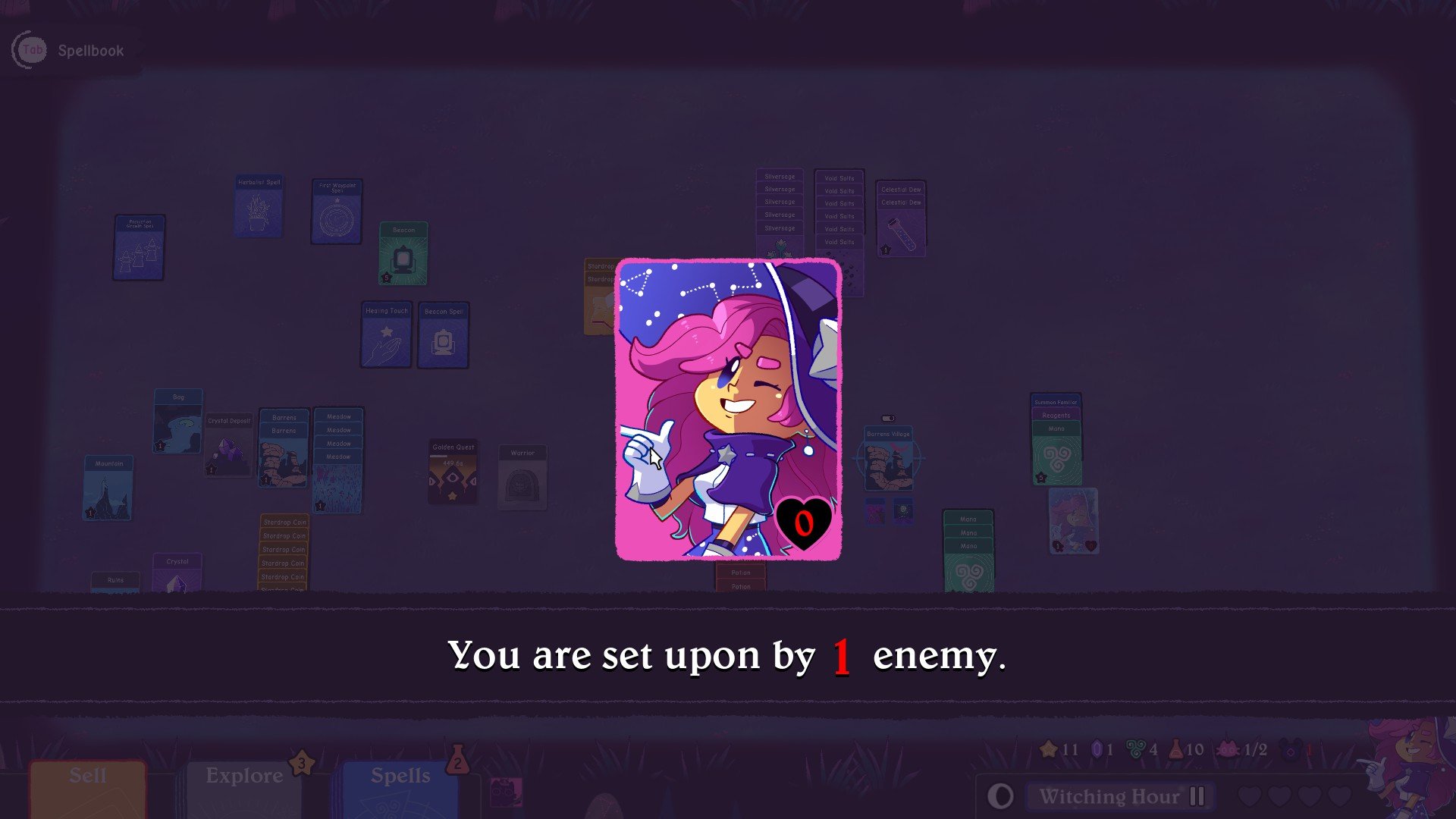
The 4X genre fuses with card management in WitchHand, which gives deckbuilding a new meaning as you conquer the ninth realm in the name of your coven. Casting spells and building villages are just part of this resource management deckbuilding title, which combines a city builder’s complexity with the simple interface of a card table. While innovative and interesting, this presentation of the genre can also be a bit much to manage, serving as the game’s main selling point and one of its biggest flaws.
WitchHand sees you playing as one of three Witches sent by your coven into a new and dangerous realm to prevent prophesized disaster. By exploring and exploiting this realm’s riches, you build an empire of Witches to withstand the onslaught of infinite darkness and impress your coven back home for endless rewards.
This exciting premise is presented fairly simply. When entering a game, you’re given a handful of resource cards, a card for your witch, and a card enticingly labeled “explore.” By dragging your Witch card to the Explore card, several more resources and a crystal cave card will drop to continue your quickly growing deck of cards. This process continues perpetually, with everything in the game achieved by combining several cards. Each card lists what needs to be combined to produce another card, with the demanded cost of resources becoming increasingly higher as time goes on.
Like most 4X games, WitchHand is generally randomized and, to a point, unpredictable. While a list of what you might find in an exploration card is listed in plain text, you can’t be sure of what exactly will come up from engaging with it. This adds an element of uncertainty that requires you to strategize around your resources and what you expect to get soon.
One area in which this uncertainty becomes dangerous is with the endless attacks from the void, creatures of presumably fae-like origin who travel between realms to stamp out your empire. They come at night (or through unlucky exploration draws) and must be stomped out by your warriors before the day ends; otherwise, they’ll do damage directly to your witch.

This looming threat is the only real way to game over in WitchHand; An unprepared Witch will quickly find themselves with insufficient health to fight back against enemies and see their run swiftly restarted. You can make warriors to do the fighting for you, but the process is particularly expensive in the early game, requiring steep investment in a tree of upgrades before you have even your first meager defender ready to fight back.
Because of this, each game of WitchHand follows a predefined path, at least for the spawn of enemies. You will not be attacked for several handfuls of nights, with the first spawn coming at the same time each time, with the same number of enemies, followed similarly by the second.
I’m not totally sure how I feel about this. On the one hand, knowing this pattern makes each new game feel like you have a pressing set of chores to rush, usually in the same order each time, knowing that you’re going to game over at a fixed point if you don’t have exactly the right things done yet. On the other hand, if these enemies attacked any sooner, thanks to a randomized spawn pattern, it would surely be a game over, as there would be nothing I could do about it.
The game has three Witches to choose from, each with different unique mechanics to play around with. While the Celestial Witch is an obvious first game playthrough (and my personal favorite of the three designs), I have to say that the Baking Witch is probably the best suited for taking the game on, simply for the constant buffs she can give with her assortment of cookable dishes.

I mentioned earlier that the game’s deck-building mechanics is the source of one of its biggest flaws, and I said the flaw is something that might sound trivial: Screen clutter.
You will quickly find, after you have, say, a village made, that most of WitchHand’s gameplay will be dedicated to sorting your cards and managing the table layout. That’s because, as resources are produced passively and you dedicate more time to exploring, you begin to amass an ever-increasing pile of resources, spells that can’t be cast yet, buildings with no place to put them, etc.
Most of these stacks can’t be collapsed, taking up a massive amount of screen space if not used frequently, and many of the passively produced or discovered new cards won’t jump onto a stack you have dedicated to that pile. I can’t tell you how many Crystals I’ve had to take over my screen simply because my villages and exploration efforts spat them out willy-nilly, and I didn’t have the patience to keep pausing the game to sort my card stacks, which unfortunately cost me precious time in the long run.
If I could complain about one thing seriously, it would be how little the game explains crucial mechanics. One such instance is the spellbook, a UI that holds all the spell production cards you unlock throughout the game, which can be placed at any time. This area also included spells I didn’t know I had, with some, like Summon Familiar, being vital for progression.

While the Spellbook isn’t exactly hidden, I don’t recall it being explained in tutorials. If I hadn’t stumbled upon this feature, I might have been hard-locked from progressing past the first invasion, and who knows just how cluttered my board would have been with cards.
Try Hard Guides was provided with a PC review copy of this game. Find more detailed looks at popular and upcoming titles in the Game Reviews section of our website! WitchHand is available on Steam.